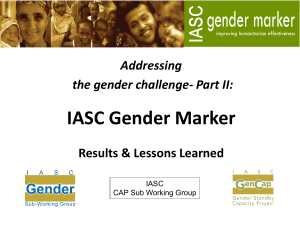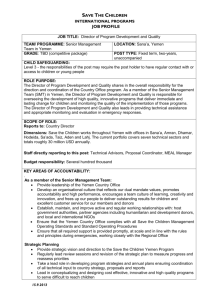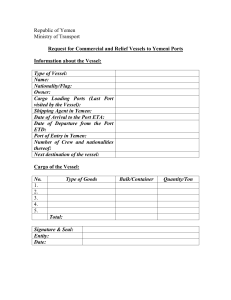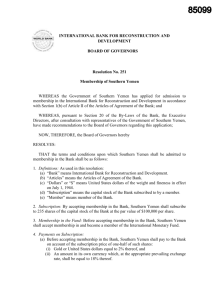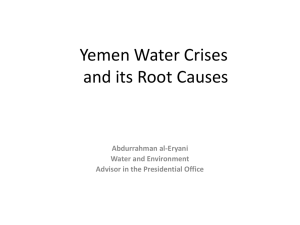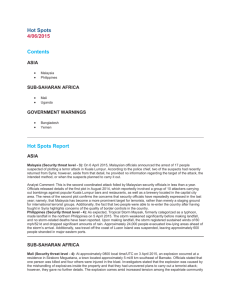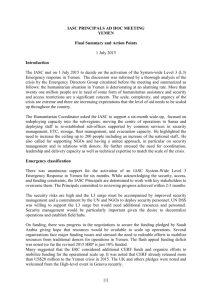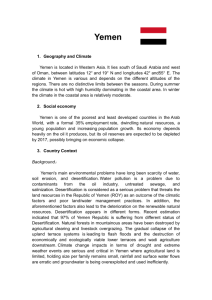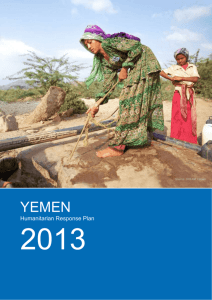HUMANITARIAN CRISIS IN YEMEN
advertisement
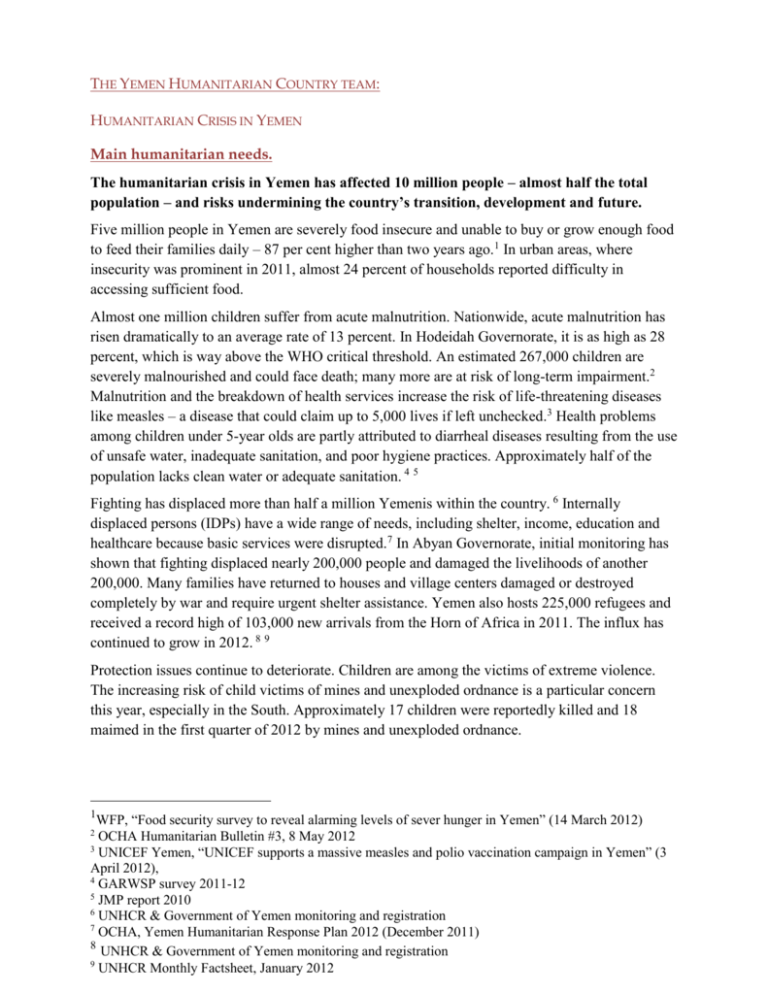
THE YEMEN HUMANITARIAN COUNTRY TEAM: HUMANITARIAN CRISIS IN YEMEN Main humanitarian needs. The humanitarian crisis in Yemen has affected 10 million people – almost half the total population – and risks undermining the country’s transition, development and future. Five million people in Yemen are severely food insecure and unable to buy or grow enough food to feed their families daily – 87 per cent higher than two years ago.1 In urban areas, where insecurity was prominent in 2011, almost 24 percent of households reported difficulty in accessing sufficient food. Almost one million children suffer from acute malnutrition. Nationwide, acute malnutrition has risen dramatically to an average rate of 13 percent. In Hodeidah Governorate, it is as high as 28 percent, which is way above the WHO critical threshold. An estimated 267,000 children are severely malnourished and could face death; many more are at risk of long-term impairment.2 Malnutrition and the breakdown of health services increase the risk of life-threatening diseases like measles – a disease that could claim up to 5,000 lives if left unchecked.3 Health problems among children under 5-year olds are partly attributed to diarrheal diseases resulting from the use of unsafe water, inadequate sanitation, and poor hygiene practices. Approximately half of the population lacks clean water or adequate sanitation. 4 5 Fighting has displaced more than half a million Yemenis within the country. 6 Internally displaced persons (IDPs) have a wide range of needs, including shelter, income, education and healthcare because basic services were disrupted.7 In Abyan Governorate, initial monitoring has shown that fighting displaced nearly 200,000 people and damaged the livelihoods of another 200,000. Many families have returned to houses and village centers damaged or destroyed completely by war and require urgent shelter assistance. Yemen also hosts 225,000 refugees and received a record high of 103,000 new arrivals from the Horn of Africa in 2011. The influx has continued to grow in 2012. 8 9 Protection issues continue to deteriorate. Children are among the victims of extreme violence. The increasing risk of child victims of mines and unexploded ordnance is a particular concern this year, especially in the South. Approximately 17 children were reportedly killed and 18 maimed in the first quarter of 2012 by mines and unexploded ordnance. 1 WFP, “Food security survey to reveal alarming levels of sever hunger in Yemen” (14 March 2012) OCHA Humanitarian Bulletin #3, 8 May 2012 3 UNICEF Yemen, “UNICEF supports a massive measles and polio vaccination campaign in Yemen” (3 April 2012), 4 GARWSP survey 2011-12 5 JMP report 2010 6 UNHCR & Government of Yemen monitoring and registration 7 OCHA, Yemen Humanitarian Response Plan 2012 (December 2011) 8 UNHCR & Government of Yemen monitoring and registration 9 UNHCR Monthly Factsheet, January 2012 2 Humanitarian response (UN agencies, INGOs and LNGOs) National and international aid agencies, together with the Government of Yemen, have continued to reach populations in need throughout the crisis and security problems. The UN agencies together with international and local non-governmental organizations formulated a coordinated Yemen Humanitarian Response Plan 2012 (YHRP), which is currently under implementation. It targets six million beneficiaries for emergency aid at the cost of US$589,734,356 for 11 clusters. This amount represents a 27 percent increase on the original YHRP and targets 2.3 million more people. So far, $249 million has been received. Requirements for food and agriculture, which increased by 30 percent at the recent Mid-Year Review, are expected to increase by a further 15 percent at the end of the third quarter of 2012, including new programming in Abyan. Response to the vital, basic and urgent water and sanitation, shelter, safety and security, health and early recovery needs of the affected population in the South, will require about $91million. More than 60 international agencies and organizations are now based in Yemen, actively responding to the country’s acute humanitarian crisis. . More collaboration and partnerships with local NGOs is evident. In addition, regional organizations like the Organisation of Islamic Cooperation have began setting up office in the country to coordinate with others and help mobilize funding in response to the humanitarian needs. Efforts to strengthen operations capacity are now showing results. Between November 2011 and April 2012, the number of international UN and INGO staff increased by 55 percent, while national staff increased by 44 percent.10 Given adequate funding, the humanitarian community stands ready to expand operations to reach more communities in need across the country. If we do not act today, the crisis will get worse. The attached map shows areas where humanitarian agencies and organizations currently work. 11 The risk to the transition and future development Gaps in humanitarian response would undermine Yemen’s political transition and prospects for peace and long-term development. Yemen requires a broad range of support including critical rapid interventions. Without emergency support from the international community, Yemen may not recover from the shocks of last year enough to carry forward a successful transition and secure prospects for longer-term development. Approximately 42 percent of the population lives below the national poverty line and youth unemployment stands at 53 percent. 12 13 Families are swimming debt as, in 2011, one third of all food purchases were made on credit, often from moneylenders.14 Evidence shows that immediate economic problems are a severe threat to long-term stability and kick-starting livelihood 10 OCHA Yemen Humanitarian Bulletin, Issue #3, 8 May 2012 OCHA May 2012 12 UNDP, Yemen in Figures, 2007. 13 UNDP, Poverty Reduction, January 2012, for age group 15-24. 14 WFP, CFFS, March 2012 11 opportunities is crucial. Experience around the world underscores that securing safe and sustainable solutions for persons affected by crisis is essential to national and regional stability. As a result of conflict, 300,000 children lack access to quality education. Many schools were destroyed, are being used by armed groups, are housing IDPs or have been rendered inaccessible by the fighting.15. In 2010, only 72 percent of girls ages 15-24 learned how to read and write.16 Even then, dropout rates for girls are high. As families struggle to meet their families’ basic needs, children’s futures are put at risk: more girls than boys have to work; child marriage and youth pregnancy are common. The maternal mortality rate (MMR) remains high at 370/100,000. This high rate is associated with early pregnancy and limited access to family planning and reproductive health services.17 Children were recruited or used to support military goals by all sides involved in conflict. 18 The government has expressed its commitment to end the use and recruitment of children, but needs further support to implement a concrete action plan. It is estimated that the current crisis has pushed back Yemen’s development by a decade.19 Further resources are required to jumpstart the economy and basic services to provide a sustainable basis for development. International organizations have committed to working with Yemeni governmental and non-governmental bodies to increase local capacity to deliver aid according to international standards and to withstand future shocks. Locations where agencies and organizations currently work 15 OCHA Yemen Humanitarian Bulletin - Issue 2 (5 April 2012) UNDP 2010, MDG status at a glance 17 UNICEF, period 2006-2010 18 Yemen Times, 16 April 2012 19 H.E. Minister of Foreign Affairs of the Republic of Yemen (1 February 2012) 16
